Wow. What a year. The leaves are finally starting to show their faces and bud, and the once very muddy trail is dry enough for steady footing. The curled fiddleheads are now very visible, and poking out of the dirt. The brook is now steadily flowing, and the forest floor is covered in sprouting plants. I see other students walking by, enjoying the sunny day. The entire university community regularly enjoys this conserved area in warm weather, and its inspiring to see. The way the usage of land has evolved over the years is amazing. From agricultural land to maturing hardwood forest, nature is reclaiming the land. After spending a semester watching the seasons pass and the scenery change, I feel a part of the landscape. I have evolved along with the landscape, and just like the perpetual changing of seasons, I am perpetually learning. Understanding the fundamental science of the location I stand on changes the way I look at the location, and it adds so much to the personal connection I have with the land. Thank you so much for reading with me, it’s been a fantastic year, and I’m thrilled for the years to come!
17 Apr
Is it Spring Yet? Is it Spring Yet? Is it Spring Yet….
No. Definitely Not. My boots sunk into the slush ever so slightly as I once again returned to the side of Centennial Brook. I brush away the snow in search of fiddleheads emerging from the soil, but only find the slightest green bumps protruding from the center of a few ferns. The red maples seem to be further along in the budding process, and the red clusters can be seen from 50 feet below the towering trunks. I hear the whirring of cars in the distance, and am reminded I am just yards away from the bustling UVM campus. I’m at the edge of an isolated interior forest block, but its hard to forget I’m surrounded by civilization on all sides. I hear a pileated woodpecker in the distance, and am filled with hope that interior forest species can prosper in such a small block of woodland. The increased traffic from Burlington and the university definitely take a toll on the ecosystem, and the trail is worn and muddy from the slushy snow. I shrug and figure its better the ecosystem is somewhat preserved rather than more academic or residential buildings. As always, thanks for reading! It’s hard to see such a lovely place be so affected by surrounding development, but as long as respect is maintained and the forest is allowed to thrive to the best of its abilities.

Above: sketch of fiddlehead emerging from snow.
18 Mar
On the Road Again…
Hey everybody!
Spring break is upon us! I’m not going to Daytona or Miami to party my face off, but I can’t complain going to California from icy Vermont. As my plane descended into Los Angeles National airport, I couldn’t help but feel a sense of despair as my skyline switched from the beautiful Green Mountains to the US Bank building and Wilshire Grand Center. After spending a few days poolside and soaking up the sun, I decided to take advantage of the weather and drive just minutes away to the sweeping foothills of the Santa Monica Mountains. As I stepped out of the car at the Victory Trailhead I was greeted with an unfamiliar emerald green, as the drought ridden valley I call my home had finally been graced with some rain. As I walked down the trail I remembered these loping valleys were once a part of Ahmanson Ranch, a ~3000 acre ranch that was almost purchased by banking giant Washington Mutual to be covered with housing developments, tarnishing one of the few truly open spaces in Los Angeles County. Thanks to the fierceness of activists and environmentalists, the space was preserved and is now owned by the state. The agricultural activity didn’t seem to have a huge impact on the land, as the hills look identical to the foothills on the opposite side of the mountains. Coast live oaks dot the landscape, breaking the monotonous waving of tall green grasses and the invasive bright yellow mustard plant. The coast live oaks are still bare, but the buds seem to be maturing and will probably open soon. I searched the landscape for identifiable birds throughout my hike, but turned around empty-handed and defeated. Finally, as I fumbled in my pockets for my keys, the screech of a red-tailed hawk pierced my ears as it cast its shadow over me. Counting it as a win, I turned the ignition and high tailed it back home. Thanks again for reading!



5 Mar
Natural Community of Centennial Woods
Hello all,
As I stood at the banks of the creek in my shady spot in Centennial Woods, the snow crunching under my feet were the only distinguishable sounds I heard. The naked branches of red oaks and sugar maples loomed over me, while the trigonal cones of Eastern white pines stood tall and green. There is some diversity between gymnosperms and angiosperms, but the forest is maturing and the nude hardwoods around me signified that I was standing in a Northern hardwood forest. The more hilly sections of the forest behind me seem to be composed of more acidic soil, as there is an abundance of Eastern white pines. The creek is still frozen as it was when I last visited, and there seems to be about an equal amount of snow underneath me. Being from California, I always assume spring will start in March, but Vermont has other plans. I see no buds and no green on the landscape, just strokes of white and brown. Using the Biofinder GIS program to further investigate ecological characteristics of my spot, I discovered that Centennial Woods is both a priority of conservation activities because of its physical landscape and because it is an block that contains interior forest. The physical landscape of this location has been shaped by thousands of years of glacier activities and sediment buildup from Lake Champlain, and to develop it would disturb the geological and ecological processes that have previously been perpetually driven. Centennial Woods is an interior forest block, which means it is a block of continuous forest, rather than a something like a roadside strip. This buffers the edge effect and allows a greater diversity of species to thrive within the forest. I hope this has been as educational for you as it has been for me! I’m starting to fall in love with the landscape and I hope I’m able to get that across.
7 Feb
A Phenological Exploration of Centennial Woods – A New Beginning
https://goo.gl/maps/adnSm9uV1SQ2
I decided to choose a new location for the spring semester phenology project, as I felt the Burlington Country Club golf course was not exactly a good location to observe natural phenological processes due to the overwhelming human influence in the area. To get to my new phenology spot, I entered Centennial Woods by the UVM Medical Center and continued down trail until reaching the meandering frozen stream. At this point I decided to wander off trail to the left until I came across a small clearing that borders the stream. There were many signs of wildlife at my location.First, I discovered what I believe to be the tracks of a cottontail rabbit, who crossed the stream I stood on the bank of and continued down the bank back into the denser sections of forest. As I stood photographing the evidence of wildlife imprinted into the snow, the familiar smacking of beak against bark was clearly audible. I was lucky enough to spot a pileated woodpecker searching for food in a nearby tree. After I made my presence known with a stumble, the pecking stopped but the bird remained in the tree. Some deciduous tree species I was able to identify by their buds and bark were sugar maple, red maple, Norway maple, and paper birch, with one bud that I was unable to identify.
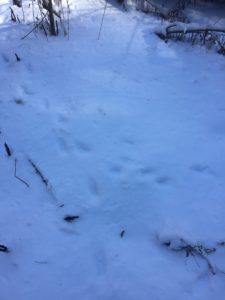
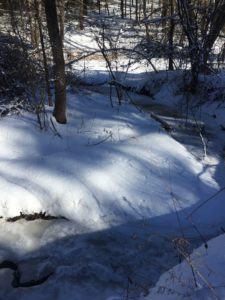
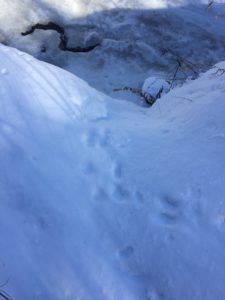
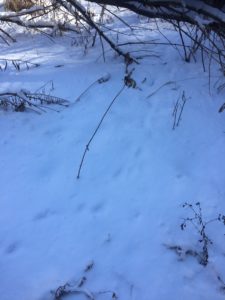
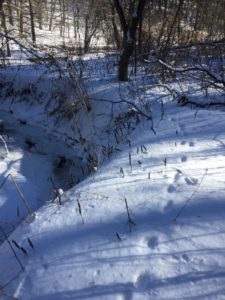
Pictured above: Tracks of what I believe to be a cottontail rabbit.
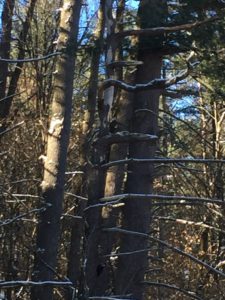
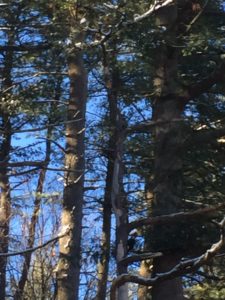
Pictured above: Pileated Woodpecker, located towards the bottom, red feathers on head help with identification.
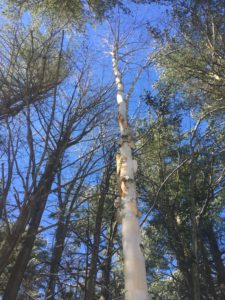
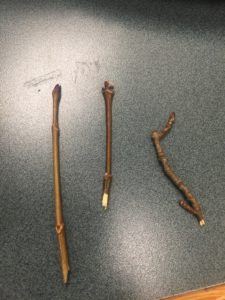
Pictured above: Paper Birch on left, buds of sugar maple and Norway maple and one bud that I was unable to identify
.
Pictured above: Sketch of Norway Maple Bud
9 Dec
Saying Goodbye – A Phenological Retrospective
I never have been good at saying at goodbye, so this isn’t going to be easy. With you, my readers, we have explored a world that would otherwise remain unobserved, that lies not too far off from where I lay my head at night. Together, we have identified tree species, spotted wildlife, and examined the natural history of a spot that is now dear to my heart. After doing a bit of research on the history of the Burlington Country Club, I learned that the 150 acres that the golfing community takes up was purchased in 1924 from Fairholt Estate. The Fairholt estate was built in as a summer home for publisher Henry Holt in the 1890’s, and designed by Frederick Law Olmsted, architect of Shelburne Farms and Central Park in New York. The location has been transferred from owner to owner over the years, but the land was remained mostly unharvested and unused for agricultural or natural resource collection for the last one hundred years. However, being close to the road and because of other signs of evidence, I am assuming my forest is young. There is not an excess of paper birch, an early succession species, but the dominance of eastern white pine in my clearing shows evidence of forest age. The prominence of sugar maple also leads me to believe this small stretch has been established for around 20-30 years. The connection I have formed with this forest grotto is indescribable, as I have watched the seasons change and Mother Nature put the world around me to sleep.
29 Nov
Off to the Hills of Southern California
Highlands of the Los Angeles Basin

In the style of Aldo Leopold – The sounding of rushing wind pounds my ears as I turn to face the burning red sky. The grasses I like to remember as waving, deep green, and full of life now lay sun dried and dormant. The echo of a hawk’s screech echoes throughout the valleys and hills of the Las Virgenes Highlands. The oak dotted chaparral foothills of the Santa Monica Mountains that seperate the San Fernando Valley from the rest of the Los Angeles Basin are unique, and its mostly unforested features allow for exquisite views in all directions. The mighty blue Pacific lies just to the west beyond the green tinged Santa Monicas, while to the east the snow capped peaks of the San Gabriel mountains are visible through the valley haze. The tall grass poked my sides as I maneuvered my way through a skinnier section of trail, and the barren coast live oak branches hauntingly hanging above my head reminded me this landscape would soon resemble the meadows featured in The Sound of Music once the rains of spring came. As the sun dipped below the 3000′ peaks of the Santa Monicas the all too familiar yipping of a pack of coyotes was audible, sounding relatively close to me, presumably hunting a cotton tail rabbit. Dust covered my sneakers as I trudged back to the trailhead, the cold of dusk seeping over the hills, dark fully enveloping my surroundings as I drove back down into the valley.
In the style of Mable Wright – The cool, damp woods surrounding Burlington differ greatly from the sweltering savannah of Southern California. In the forested Champlain Valley, mixed armies of deciduous and coniferous trees stand tall and at attention as far as the eye can see, and the mess of sticks and leaves are sparsely covered by pearly patches of snow. A blanket of snow covers the surrounding vegetation rather than dust, and the timid sun sparingly graces the cold earth with its presence. Poison ivy is the largest threat in my wooded grove rather than menacing rattlesnakes, however I find myself warier of the former. Amongst the bald foothills of the Santa Monica mountains, the lone oak guards its sanctuary on the summit, and its naked form prepares to embrace the cooling rains to come, needing to be refreshed after months of intense heat and sun exposure. The loud howls of coyotes fill the nights on one side of the country while the silence in Vermont is unbroken except maybe by the hoot of a snow owl or the stirring of a bobcat. Wind blows both through the coastal California grass and Vermont maples, and no grass in either region is a stranger to swaying. As the day comes to an end, the moon rises amongst the clouds of east while the sun beams strongly in the west, continuing its reign for another 3 hours.


7 Nov
Winter is coming…
Winter is coming…
Hey! It hasn’t been too long since my last blog post, but my nestle of wooded peace alongside the Burlington country club has experienced many changes since I last wrote. Last time, during the peak of foliage, the leaves were golden, red, and green, and clung onto the trees. Now, many of the trees that surround me are bare and look haunting in their dusky backdrop. The forest floor is littered with brown and decaying leaves, and there is very little visible insect activity. I am excited to see how my spot will look covered in snow and I can’t wait to breathe in the cool winter air.
My Event Map

My Poem
Days pass by fast like a hummingbird.
Late afternoon, chatty chirps and whistling wind come together to
produce the most beautiful song I’ve heard.
Leaves crunch under my feet,
Signifying the end of one season and the beginning of the next.
Sitting alone in the woods just cannot be beat.
I will soon bring out the jackets with down,
But while shivering in the nighttime rain I’ve found it hard to frown.
23 Oct
Blog Post 2 – Map and More

Some changes in vegetation that I have noticed since my last visit is that the leaves of the hardwoods have began to change color and fall, and one of the box elders have even become leafless. The conifers have not seemed to undergo any changes, nor have the shorter plants such as the poison ivy. It is also now difficult to see the forest floor due to the increase of leaves on the ground. It is difficult to observe changes in the shrubbery as it is as unkempt as before. This visit an owl graced me with its presence as it was perched at the top of an eastern white pine and hooting. It was too dark to try to identify the owl, but that was the only animal presence I have observed at my spot.
2 Oct
Forested Area of Burlington Country Club

My location for the phenology project is the wooded area complete with a small clearing that is right off the golf course of the Burlington Country Club. To get there, I take a left on South Prospect St. from the Redstone dorm complex until I reach the club. Then, making a right turn right after entering straight into the woods. I chose this place for a couple of reasons. First, it is very close to my dorm building so it is very accessible. Second, it is a beautiful plot of land with spots of native Vermont forest, so I thought it would it be a good example for this project. Finally, I saw an owl there during my first visit so I figured it would be a good place for wildlife spotting. There is dense vegetation including poison ivy along with the hardwood forest floor which is characteristically covered in leaves and branches. Some wooded plants I observed in this plot included, black cherry, eastern white pine, striped maple, and green ash.
https://www.google.com/maps/@44.4608797,-73.1915993,18.88z
Recent Comments